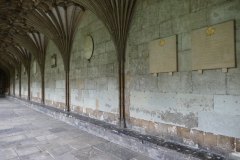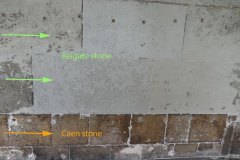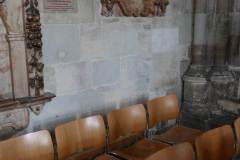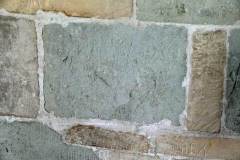Basics
Geology: fine-grained sandstone
Rock unit: Upper Greensand Formation
Age: Lower Cretaceous
Provenance: Merstham, Surrey
Where to see examples
- south wall of the main cloister (images 1 and 2)
Description
Reigate Stone is referred to as Merstham Stone in the medieval fabric rolls in the Cathedral Archives. It was quarried, or perhaps more accurately mined, from the outcrop on the south-facing slope of the North Downs near Godstone in Surrey. Reigate Stone is a sandstone, cemented by calcium carbonate, and has been used as a building stone since Saxon times. The stone was used extensively in London during the medieval period when it was the “local” building stone for the capital. The Crown owned the quarries, which provided much of the building material for royal projects such as Westminster Abbey and was also used for the old London Bridge built in 1176. However, Reigate Stone was used more for its convenience and its ability to be easily carved than for its durability. Sir Christopher Wren spoke in slighting terms of its use in masonry buildings. The small clay content in the sediments has repeatedly led to the failure of the stone when used for external work. A more traditional use for Reigate Stone has been for building local boundary walls. It has also proved a competent refractory stone and has been used in many chimneys, ovens and kilns. When ground down to a fine powder it has been commercially produced as a whitener for hearthstones.
In the locations quoted, this stone has a distinct green colour. This is because of fine grains of the iron mineral glauconite, hence the term “greensand“. Note the irregular dark patches on some of the stones. This is chert, a form of silica. It is extremely hard and stands proud of the surrounding stone indicating how much sandstone has been weathered away since the wall was built. The chert bands are all contained within the stone blocks indicating the quarrymen sensibly avoided cutting through this intractable material.




